Connection Guide : End Plates
| Disclaimer: This guide is not comprehensive. It shows only a few of the many end plate connections that connection design can create. |
Also see :
- End plate (index)
- End plate connections (help page)
- Connection design locks (to customize end plates)
- Moment connections (connection guide -- includes end plates)
- Ways of generating connections in Modeling (topics)
- Status Display ( Connection type > End plate )
| End Plates Offset and Opposite | |
| Connection Design Locks = " End Plate " | |

|
Input connection type: ' End plate ' or ' Auto standard '. |
| Comments: Connection design uses the " Wide gage " or " Narrow gage " center-to-center distance in Standard Fabricator Connections on half of each plate. For the other half, the program increases the gage. | |
| End Plate to a Wide Flange Beam Flange | |
| Connection Design Locks = " End Plate " | |
| Input connection type: ' End plate ' or ' Auto standard '. |
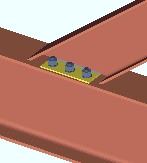
|
| Comments: Connection design can create an end plate on the end of a beam that slopes (but not skewed) to the flange of a wide flange, S shape or welded plate wide flange beam. This can be done for W, S, welded plate W, or C beams. | |
| Non-moment End Plate | |
| Connection Design Locks = " End Plate " | |
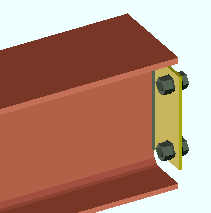
|
Input connection type: ' End plate ' or ' Auto standard '. |
| Settings: ' Wide gage ' (or ' Narrow gage '), ' Non-moment ' | |
| Comments: May be applied on a W or S or welded plate W or C or HSS rectangular beams perpendicular, sloped or skewed to a column or beam. Also may be used as a beam splice. | |
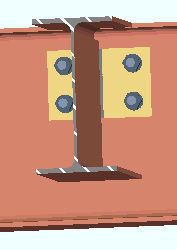
|
A non-moment end plate on a wide flange beam to a wide flange beam. Connection design automatically copes the supported beam to clear the flange of the supporting beam. The end plate shop welds to the web of the supported beam and field bolts to the supporting. |
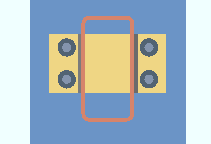
|
A non-moment end plate on a HSS rectangular beam to a wide flange column. A non-moment end plate may be applied to wide flange or S shape or welded plate wide flange or channel beams as well as to HSS rectangular beams. |
| Non-moment Offset Safety End Plates | |
| Connection Design Locks = " End Plate " | |
| Input connection type: ' End plate ' |
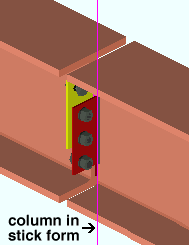
|
| Settings: ' Narrow gage ' (or ' Wide gage '), ' Safety-offset ', ' Non-moment ' | |
| Comments: Applies when two beams with end plates frame to opposite sides of a supporting column web. | |
| Non-moment Notched Safety End Plates | |
| Connection Design Locks = " End Plate " | |
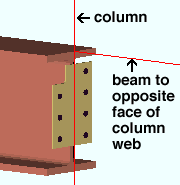
|
Input connection type: ' End plate ' |
| Settings: ' Narrow gage ' (or ' Wide gage '), ' Safety-notch ', ' Non-moment ' | |
| Comments: Applies to beams with end plates framing to opposite sides of a column web. The program " Copes " each end plate so that each bolt in the top row is shared by a different beam. For the end plate shown, the cope is near side. For the plate not shown, it's on the far side. | |
| End Plate with Welded Extended Tee | |
| Connection Design Locks = " End Plate " | |
| Input connection type: ' End plate ' |
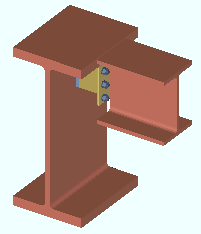
|
| Settings: " Welded extended tee " (checked) and " Full depth extended tee " (not checked).
|
|
| Design restrictions: Connection design can create the built-up tee to be the length of the end plate if the top & bottom flanges of the supported beam are entirely below or entirely above (as shown) the half-depth of the supporting beam. | |
| A full-depth extended welded tee. In this example, the welded tee is the full depth of the supporting beam because the option for " Full depth extended tee " is checked. Welded tees are always full depth when the nominal depth of the supported beam is more than half the nominal depth of the supporting beam. |
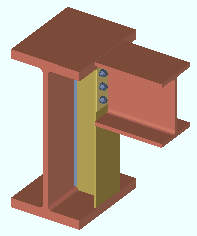
|
| Same two beams as above, but without the welded tee. When the option for " Welded extended tee " is not checked, connection design copes the supported beam to fit under the flange of the supporting beam and bolts the end plate directly to the supporting beam's web. Built-up tees can also be designed for end plates on beams in skewed framing situations. |
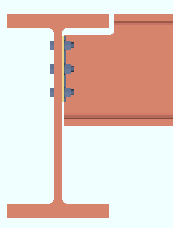
|
| Non-moment End Plate Extended to Flanges | |
| Connection Design Locks = " End Plate " | |
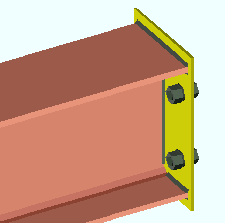 |
Input connection type: ' End plate ' |
| Settings: ' Narrow gage ' (or ' Wide gage '), ' Non-moment ', " Extend PL to beam flanges " (checked), " Extension dimension ." | |
| Comments: An axial load (" Tension " or " Compression ") must be entered. | |
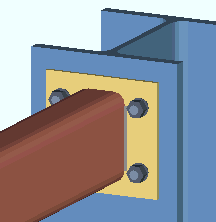
|
Here's an extend-to-flanges end plate on a HSS rectangular beam. " Extend PL to beam flanges " is checked, and an axial load (" Tension " or " Compression ") is entered. |
| Non-moment End Plate with Expanded Bolt Spacing | |
| Connection Design Locks = " End Plate " | |
| Input connection type: ' End plate ' |
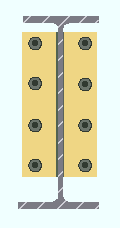
|
| Settings: ' Narrow gage ' (or ' Wide gage '), ' Non-moment ', " Use expanded vertical bolt spacing ." A " Tension " or " Compression " load can be entered, but is not required. | |
| Comments: Connection design expands the vertical spacing of bolts to either 1.5 times or 2 times the " Bolt spacing " that is set for the bolt diameter, in Connection Detailing/Fabricator Options . The " Vertical hole spacing " lock in the " End Plate " feaf can be variable spacing ( |
|
| End Plate Extended to Vertical Brace Gusset | |
| Connection Design Locks = " End Plate " (on beam), " End Plate " (on brace) | |
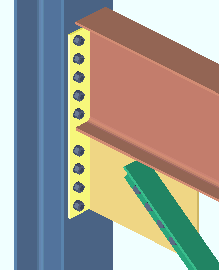
|
Input connection type: ' End plate ' on the beam, ' Vbrc plate ' on the vertical brace.
|
| Settings: ' Non-moment ', " Combine beam/vbr end plates " (checked). The end plates can be ' Wide gage ' or ' Narrow gage '.
|
|
| Framing situations: This type of connection can be designed when a vertical brace frames to a beam and column. | |
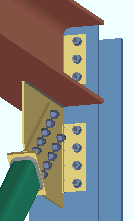
|
Beam with an end plate that is NOT combined with the end plate on the gusset to column. The beam's end plate is set to ' No ' for " Combine beam/vbr end plates ." Connection design can also combine shear plates in vertical brace to beam & column framing situations. |
| End Plate with Safety Erection Seat | |
| Connection Design Locks = " End Plate " | |
| Input connection type: ' End plate '
|
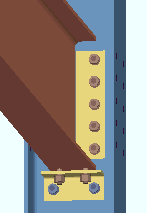
|
| Settings: ' Narrow gage ' (or ' Wide gage '), ' Non-moment '.
|
|
| Erection seat settings: " Use a safety erection seat " (checked), " Location of safety erection seat " (' Top ' or ' Bottom '). Bottom is shown. | |
| End Plate Splices (moment splice shown) | |
| Connection Design Locks = " Moment End Plate ," " Moment Stiffeners " | |
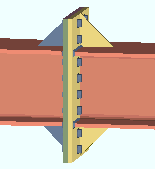
|
Input connection type: ' End plate '.
|
| Settings: ' Bolted ' moment (shown) or ' Non moment '.
|
|
| Comments: The beams must be colinear W sections. For moment splices, the sections must be the same size and the top flanges at the same elevation. | |
| Moment End Plates | |
| Connection Design Locks = " Moment End Plate " | |
| Input connection type: ' End plate '
|
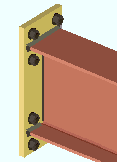
|
| Settings: ' Bolted ' moment.
|
|
| Comments: The moment connection shown is only one of the many types of end plate moment connections that connection design can create. For more information, see moment connections. | |
| End Plates on a Beam Framing to Nothing | |
| Connection Design Locks = " End Plate " | |
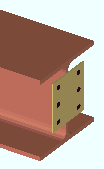
|
Comments: Unlike most connection types, end plates can be applied on members that do not frame to anything. The same is true of clip angles and bent plates and user base/cap plates . A search is available to help you locate members with indeterminate ends . |







